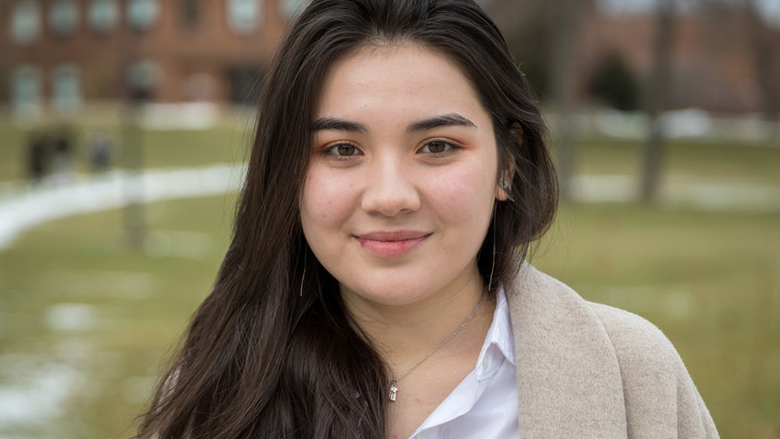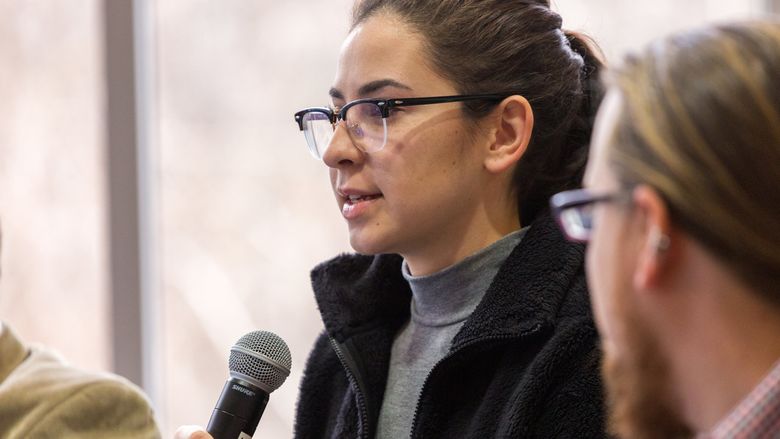Founding members of the campus Black Student League included Darryl Trent, Natalie Burrell Wells, Barry Reddish and Zawdie Abdul-Malik (nee James Garner).
MEDIA, Pa. — Four founding members of Penn State Brandywine’s Black Student League, including the group’s first president, visited the campus on Feb. 22 to discuss their experiences as college students in the late 1960s. Their presentation was part of the campus’ 50th anniversary celebration and Black History Month.
The four alumni – Brother Zawdie Abdul-Malik (nee James Garner), Natalie Burrell Wells, Barry Reddish and Darryl Trent – all enrolled at Penn State Delaware County during the 1968-69 academic year. The campus opened in September of 1967 in temporary space underneath a roller rink in Chester. The campus moved to its current location in Middletown Township in 1970 and the name was changed to Penn State Brandywine in 2007.
Abdul-Malik came to Penn State after serving four years in the U.S. Air Force during the Vietnam War. He became the founding president of the campus Black Student League. After completing his Penn State degree, he graduated from Rutgers Law School and began years of public service, including serving as a New Jersey Senate aide, a Camden, New Jersey city administrator and an elected member of the Camden Board of Education.
Burrell Wells worked alongside Abdul-Malik on the campus’ first educational opportunity program. After graduating from Penn State, she worked with the Head Start program, embarked on a career in sales and owned a catering business.
Reddish started college at the age of 16. He served as vice president of the student government association and was the only black player on the campus’ first intercollegiate athletic team — men’s basketball. After graduation, he worked for several large insurance companies before changing to a career in education.
Trent actually started classes a few months after the other alumni because of his experience on his first day at Penn State Delaware County in September of 1968. Trent said he arrived on campus, walked through the building, and “didn’t see a single person who looked like me.” When he came upon an exit door, he walked out and drove home, later returning in January of 1969.
Trent earned his master’s degree from the University of Pennsylvania and began a career in corporate communications and broadcasting.
The panel discussion was moderated by the current president and vice president of Brandywine’s Black Student League: senior Monet Bradford and sophomore Sherly Rosario.
The four alumni engaged the crowd with stories about the early years on campus, including racial and social issues of the 1960s and 1970s and their impact on black students at Penn State.
The four were active not only on campus, but with outreach in the communities around the campus and in Philadelphia, which is where three of them resided.
“Being part of the League enabled us to align ourselves with diverse groups in our community,” said Trent. “The idea of forming unions with people of like mind, regardless of ethnicity, was really key for us.”
In addition to supporting anti-racism movements in the Chester region, the League worked with children in local elementary and middle schools and encouraged them to pursue higher education.
Abdul-Malik met often with John Vairo, the founding campus director of Penn State Delaware County, to discuss programs and opportunities on campus that would benefit black students.
“I was involved with organizations of young folks who were students at Delaware County (now Brandywine), Ogontz (now Abington) and University Park,” he said. “We hosted sit-ins and did other projects. Sometimes we got called all kinds of names, but our understanding of the need for community activism drove us into the community to assist other people.”
Burrell Wells recalled that Vairo was very welcoming to the League and its ideas.
“The climate at our campus was different,” she said. “Because of one man, John Vairo, we didn’t have to demonstrate and sit in. He was amiable towards whatever would serve the better good and he took us seriously. There weren’t many people like that.”
Reddish shared stories about being the only black basketball player during the team’s first year in 1968-69. Trent joined Reddish on the team the following year, along with two other black student athletes. Once, during an away game, the Delaware County team managed to win despite a referee’s series of blatantly racist calls against the black players.
“I think that was eye-opening for the team,” Reddish said. “None of them had ever really seen racism like that before. It actually helped form a bond between us at that particular time.”
“Some of the team had never played ball with black people before,” Reddish added. “I didn’t know that the team would be a groundbreaking thing for the campus, both as its first intercollegiate sports team and in terms of racial integration, but I was happy and proud to be part of it.”
For Bradford and Rosario, the two students who moderated the discussion, it was an opportunity to learn firsthand about the history of the campus and the Black Student League.
“I was awestruck to meet these alumni who had such an impact on our campus,” said Bradford, the current Black Student League president. “They gave me the drive to continue focusing my energies on social justice issues on our campus and in our community.”
“Following in their footsteps is a tremendous honor,” she added. “Walking away from the panel discussion, I felt a sense of connection with not only the leaders but my classmates as well. I’m truly grateful for the experience. Their words show how important it is to continue to raise awareness about racial tensions that still exist in our community.”
The panel concluded with a question-and-answer session between the four alumni and the audience. The guest speakers also visited classes on campus.

